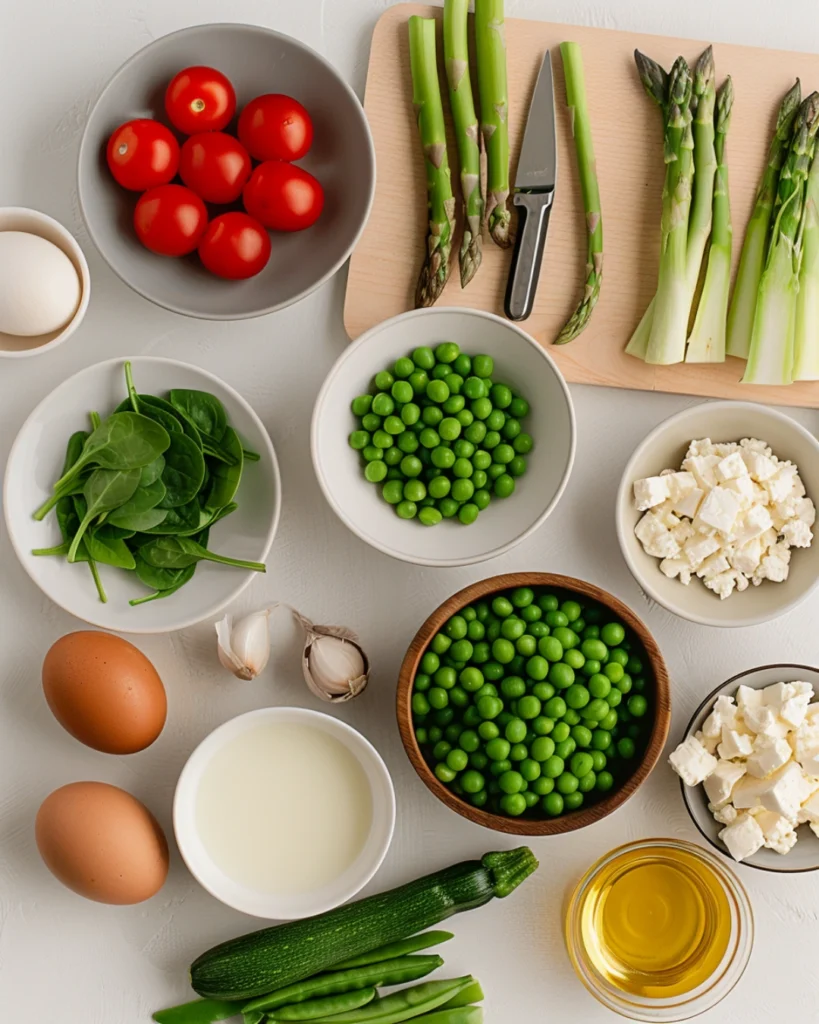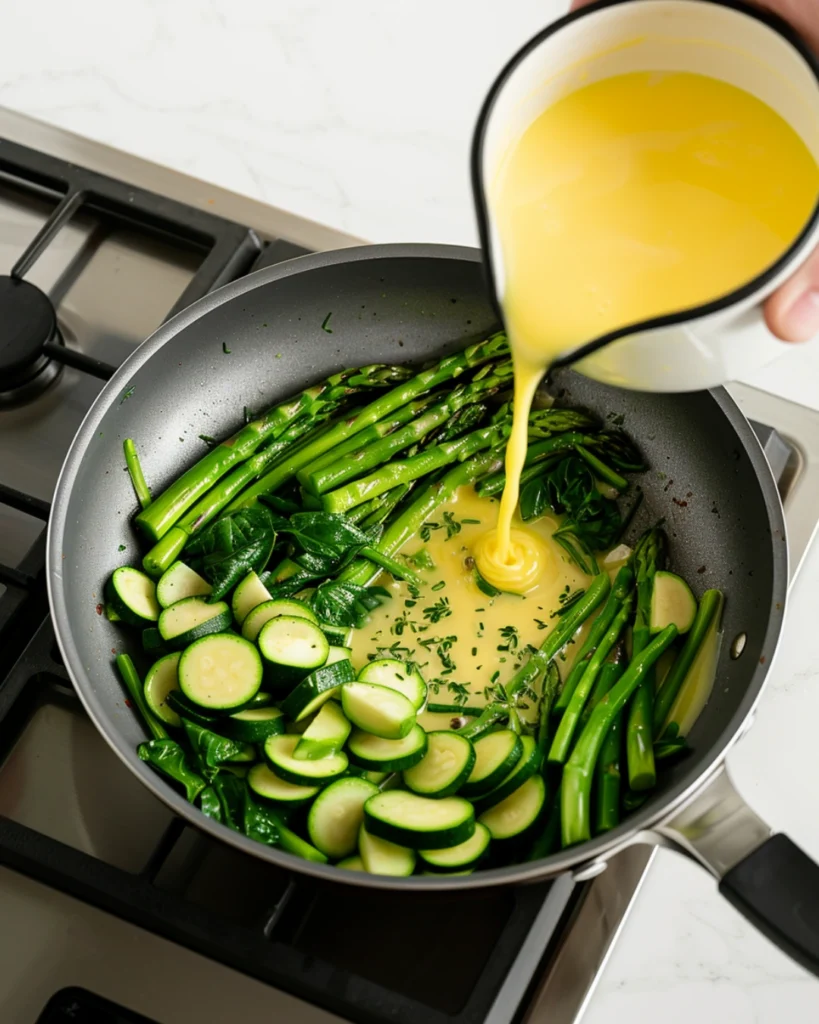Spring always inspires lighter, fresher cooking, and nothing captures the season better than a Spring Vegetable Frittata. This dish celebrates colorful produce, herbs, and simple ingredients that come together beautifully in one skillet. Whether you enjoy it for breakfast, brunch, or a light dinner, it’s versatile, nourishing, and incredibly easy to prepare. In this article, I’ll share the story of how this recipe became a favorite in my kitchen, tips for creating the perfect frittata, and delicious ideas for serving it throughout the season.
A Market Basket and a Spark of Inspiration
How Spring Vegetable Frittata Found Its Way to My Kitchen
The first time I made a Spring Vegetable Frittata, it started with a simple walk through the farmers’ market. I remember being drawn to the stalls filled with tender asparagus, baskets of baby spinach, and shiny bell peppers. Everything looked too fresh to pass up, and before I knew it, my bag was overflowing. Back home, I wanted a dish that celebrated those flavors instead of hiding them under heavy sauces.
Eggs seemed like the perfect backdrop—light, simple, and able to bring out the best in vegetables. I sautéed the produce, poured in whisked eggs, sprinkled some feta on top, and baked it. When I pulled the skillet from the oven, the result was golden, vibrant, and bursting with flavor. From that day, the frittata became my go-to dish whenever spring produce arrived.
Why the Spring Version Feels So Special
What makes a Spring Vegetable Frittata different from any other? It’s the freshness. Spring vegetables bring a brightness you don’t find in winter cooking. The eggs hold everything together, but it’s the vegetables that shine. Unlike heavier meals, this frittata feels light yet filling, making it a dish you can enjoy any time of day.
I often serve it for brunch with friends, but it’s just as satisfying on a busy weeknight when dinner needs to be quick. It’s also forgiving—if you don’t have zucchini, swap in peas; if asparagus isn’t available, use spinach.
The flexibility makes it approachable, while the seasonal touch keeps it exciting. Every slice feels like a reminder of what the season offers: color, flavor, and nourishment all in one skillet. That’s why I return to this Spring Vegetable Frittata each springm it’s simple, wholesome, and full of life.
Building the Foundation of a Frittata
Seasonal Ingredients That Shine
The beauty of a Spring Vegetable Frittata lies in its simplicity and adaptability. At its core, the dish uses everyday staples paired with the season’s freshest produce. Here’s what you’ll need to create a bright and nourishing base:
- 6 large eggs – the structure of the frittata
- ½ cup milk or cream – for lightness and texture
- 1 cup asparagus, chopped – crisp and seasonal
- 1 small zucchini, sliced thin – adds moisture and color
- 1 cup baby spinach or kale – leafy greens for nutrition
- ½ cup cherry tomatoes, halved – a juicy burst of flavor
- ½ cup peas (fresh or frozen) – sweet and tender
- ½ cup cheese (feta, goat cheese, or Parmesan) – richness and tang
- 1 small onion or 2 scallions, diced – gentle sharpness
- 1 tablespoon olive oil – for sautéing the vegetables
- Salt, pepper, and fresh herbs – to season and brighten
This combination balances freshness with richness, resulting in a dish that’s colorful, satisfying, and wholesome.

Simple Steps for a Reliable Base
Start by heating olive oil in an ovenproof skillet, then sauté the onion, asparagus, spinach, peas, cherry tomatoes, and zucchini are ideal for this season, offering brightness and nutrition in every bite. These vegetables provide vitamins, minerals, and antioxidants that support overall health, as highlighted by the Harvard School of Public Health.”
Add peas, tomatoes, and spinach for a quick stir. Whisk eggs with milk, herbs, salt, and pepper, then pour them over the vegetables. Scatter cheese on top and let the edges set on the stovetop. Finish baking until puffed and golden. The result is light yet satisfying, much like a comforting bowl of curried pumpkin soup on a chilly day.
What makes this Spring Vegetable Frittata shine is its adaptability. Swap zucchini for mushrooms, or try bell peppers for sweetness. It’s the same flexibility that makes dishes like creamy cottage cheese pasta or spooky dark sangria such kitchen favorites—simple techniques that celebrate seasonal ingredients.

Secrets and Simple Variations
Keys to a Perfect Frittata
The secret to a good Spring Vegetable Frittata is all in the texture. The eggs should be light and custardy, never rubbery. This comes from proper whisking, which incorporates air, and gentle cooking. Start by whisking the eggs thoroughly with milk to create structure, then cook the frittata slowly so the edges set without overcooking the center. A nonstick or cast-iron skillet helps with even heat and an easy release.
Seasoning also matters—herbs like dill, basil, or parsley elevate the freshness and ensure the eggs don’t taste bland. Think of it as layering flavor, the same way a hearty shepherd’s pie balances simple ingredients into something extraordinary.
Variations to Keep It Interesting
The beauty of a frittata is its versatility. Swap in mushrooms for depth, or add artichoke hearts for a Mediterranean feel. Prefer sweetness? Toss in shredded carrots or red bell peppers. Cheese can also change the flavor dramatically: mozzarella for mild creaminess, cheddar for sharpness, or feta for tang.
For those who love a protein boost, adding chickpeas brings substance, much like the satisfying chickpea feta avocado salad. You can also give the dish a brunch twist by pairing it with seasonal sides such as pumpkin spice pancakes or balancing it with lighter meals like Greek chicken bowls.
No matter how you customize it, the frittata remains reliable. It adapts to what you have on hand, making it just as suitable for a casual weeknight dinner as for a celebratory weekend brunch. Each variation highlights seasonal flavors in a new way while keeping the essence of the dish intact.
Serving, Storing, and Pairing Ideas
How to Serve It Best
A Spring Vegetable Frittata is versatile enough to fit into any meal of the day. For breakfast or brunch, pair it with a simple side of fresh fruit or a slice of crusty bread. The vibrant vegetables make it colorful enough to stand on its own, but a small green salad with a light vinaigrette balances the richness of the eggs and cheese beautifully.
If you’re serving it for lunch, cut it into wedges and enjoy it with a bowl of soup for a satisfying combination. For dinner, add roasted potatoes or a grain-based side such as farro or quinoa to make it more filling. What makes it special is its adaptability—you can dress it up for guests or keep it casual for a weekday meal.

Storing and Make-Ahead Tips
This Spring Vegetable Frittata is also an excellent option for meal prep. Once cooled, store leftover frittata in an airtight container in the refrigerator for up to three days. To reheat, warm slices gently in the oven or in a skillet over low heat to preserve their texture. Avoid the microwave if possible, as it can make the eggs rubbery.
The frittata can also be enjoyed cold, making it a convenient option for packed lunches or quick snacks. For longer storage, you can freeze portions by wrapping slices tightly in foil and placing them in a freezer bag.
When ready to eat, thaw overnight in the refrigerator and reheat in the oven. Having a frittata ready to go means you’re never far from a wholesome, seasonal meal. Its make-ahead potential adds to its appeal, making it not just a recipe for spring but a staple for busy kitchens year-round.


Spring Vegetable Frittata
Ingredients
Equipment
Method
- Preheat oven to 375°F (190°C).
- Heat olive oil in an ovenproof skillet over medium heat. Sauté onion, asparagus, and zucchini until tender.
- Add spinach, cherry tomatoes, and peas; cook for 2 minutes more.
- In a bowl, whisk eggs with milk, herbs, salt, and pepper.
- Pour egg mixture over vegetables in the skillet. Sprinkle cheese evenly on top.
- Cook gently on the stovetop until edges begin to set.
- Transfer skillet to oven and bake for 12–15 minutes until puffed and golden.
- Let cool slightly before slicing and serving.
Nutrition
Notes
For a dairy-free version, skip cheese or use plant-based alternatives.
Serve warm, at room temperature, or chilled for meal prep.
From your stove to our hearts
share your delicious take!FAQ: Spring Vegetable Frittata
What is vegetable frittata made of?
A vegetable frittata is made with a base of whisked eggs, often combined with a splash of milk or cream for tenderness. Fresh vegetables such as asparagus, spinach, zucchini, peas, and cherry tomatoes are classic spring choices, while cheese like feta, goat cheese, or Parmesan adds richness. The ingredients are combined in a skillet, cooked gently, and finished in the oven until golden and fluffy.
What is the secret to a good frittata?
The secret is all about texture and balance. Whisk the eggs thoroughly to add air and keep the center light. Cook the mixture gently so the edges set without becoming rubbery, then finish it in the oven for even cooking. Generous seasoning and fresh herbs ensure the flavors shine. Choosing the right skillet, such as nonstick or cast-iron, also makes for a perfect result.
What is the difference between an omelet and a frittata?
Although both are egg dishes, they differ in preparation. An omelet is cooked quickly on the stovetop and folded around its fillings. A frittata is cooked more slowly, with vegetables and cheese mixed directly into the eggs, then baked to set. This gives the frittata a thicker, more substantial texture that can be sliced into wedges and served warm or cold.
What do Italians serve with frittata?
In Italy, frittata is often served with simple sides that complement its flavor without overpowering it. Crusty bread, roasted potatoes, or a fresh green salad are traditional pairings. Depending on the meal, it can be enjoyed warm from the skillet for brunch or cooled to room temperature as part of a light dinner spread.
Conclusion
The Spring Vegetable Frittata is more than just an egg dish, it’s a celebration of the season’s brightest flavors. With asparagus, spinach, zucchini, and cherry tomatoes, it captures the freshness of spring in every slice. The combination of creamy eggs, tender vegetables, and a touch of cheese creates a dish that’s both nourishing and satisfying, while still feeling light.
What makes this Spring Vegetable Frittata so appealing is its versatility. It can be enjoyed for breakfast, brunch, lunch, or dinner, and it works equally well for casual meals or gatherings with friends. Leftovers store beautifully, making it an ideal choice for meal prep or busy weeks. Most of all, it’s a recipe that encourages creativity, you can swap ingredients, play with herbs, or adjust cheeses to match your taste.
Whether you’re looking for a quick weeknight dinner or a centerpiece for spring entertaining, this frittata is a simple, wholesome dish worth returning to again and again.
